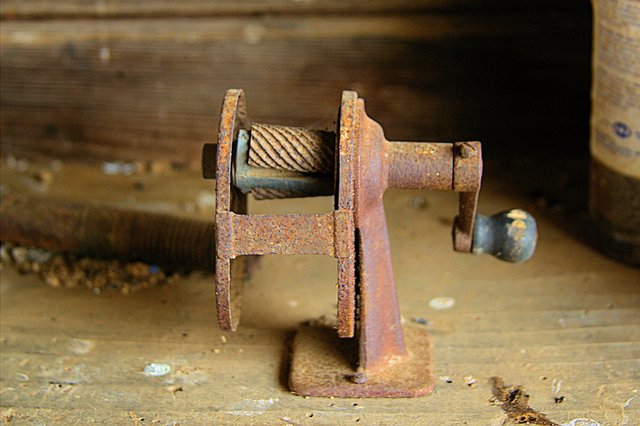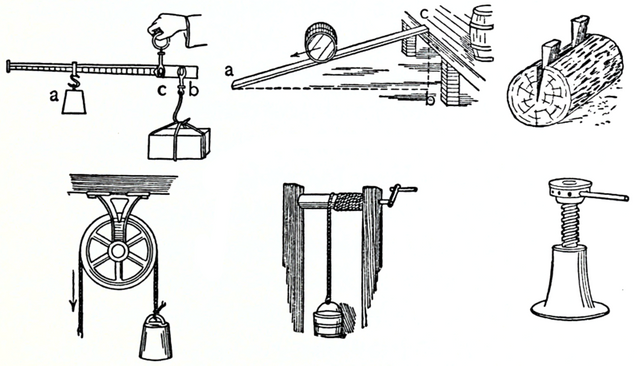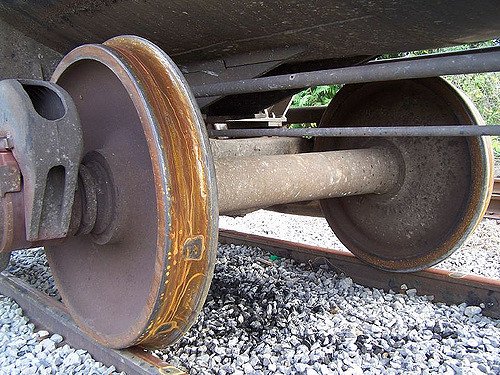My movie inspired take on Machines — A basic approach to understanding simple machines.

Let's imagine you're an 8 grader in music school, and your teacher is preparing the whole class for an upcoming musical concert. He needs to move the piano from the third floor of the school building to the first-floor gym area. The piano fits easily through the classroom door, but from there, it's trouble because it seems the instrument would have to be carried down the multiple flights of stairs. Imagine how tedious and silly that would be. Chances are that the piano could suffer several damages should it even make it outta the stairs area in one piece. Soon it becomes clear that taking the stairs would be a very bad idea.
So, everyone thinks long and hard, and then... Bing! Someone figured out there might be a way to lower the piano through the window of the third floor to the window of the first's, but the class was gonna need some kinda device to fasten the piano too, and then lower it ever so slowly and gently. Whatever it was, They were gonna need a machine.
What are machines?


If ever you have seen the 2009 Indian comedy-drama aired by Vinod Chopra films, - 3 Idiots, then you most likely had a good laugh when at some point in the classroom, Chatur gave this weirdly long definition of a machine thus:
PS: Try reading this with your best Indian accent for a start. 😉
"Sir, machines are any combination of bodies so connected that their relative motions are a constrained. And by which means force and motion may be transmitted and modified as the screw in its nut or a lever range turnabout a fulcrum or a pulley by its pivot etc. esp a construction more or less complex consisting of a combination of moving parts or simple mechanical elements as wheels, levers, cams etc" -source
"Excellent", replied the lecturer, almost marvelled at the sheer brilliance of the American born actor.
But, did anyone understand half of that statement? I still believe that I am not the only one who thought that kind of definition was totally unnecessary and uncalled for. So this is me not paying any attention to what he said in the above, but I put it up there regardless, for some of my readers that seem to enjoy things being overly complicated.
If you're all up for simplicity like myself and my buddy Rancho, here's something you can relate to; By definition, a machine simply is anything that makes your work easier and more efficient. A screw, a peg, your car, a bicycle, a plank used to roll some cylinders up the back of a pickup van, your regular forks and knives for eating and slicing, etc. These are all examples of machines because somehow, they aid you to complete a task smarter and better without spending too much energy.
Machines are all around us, even more than we do realize, and they have played very meaningful roles in civilization over the years. By the help of machines, humans can move the otherwise unmovable, and approach places that would be otherwise unapproachable. Complex machines such as bulldozers have made road construction easier, aeroplanes have made travel feel like a breeze, and rocket-powered spacecraft have made it to the moon and back, rendering a whole lot of the mystery behind space a thing of the past.
We won't be considering the heavy or complex machines today, I'd prefer taking a general overview on the basics of machines. - The simple machines.

An overview of machines.
Whether they're simple or complex, one way machines make our work easier is by amplifying the forces we have to offer. Hence, making it seem easier to do tasks. They do that by changing the direction or size of the force needed to do work.
Basically, whenever we use machines, Two very important forces are in play.
- The effort force.
- The resisting force or load.
The effort force is the force you applied to a machine. By pushing down on a screwdriver in order to remove the lid off of a can of paint, for example, you're applying the effort force.
Whereas, the force acting in direct opposition to the effort is called the resistant force. In the example above, since the liquid paint's lid offers some measure of resistance, it is correct to say that it is the load or resisting force.

Maybe we should just throw the damn thing outta the window, since no one thought it wise to phone the Piano company. Image by Prayitno, Flickr.
Rounding off our brainstorm story about gullible kids, music teachers and pianos at the beginning of this article, we're gonna need a list of things involving ropes, boards, wheels and pulleys, etc to help make it easier.
By setting up some rigid support up in the roof, the rope and pulley could be used to raise or lower the piano through the building's windows. And if the piano does not have wheels of its own, moving it across the floor would be a lot easier using a flat, sturdy board with rollers below it. If none of this works, get a new piano. With a few more greens off the school's wallet, this one works, every time.
Again, it is notable to say that while machines reduce the effort required to do work, it doesn't save the work or reduce the load itself. Hence, you cannot eliminate totally the need for a little input of effort, no matter how little, One has to put in the effort at least to get work done.

Mechanical advantage and mechanical efficiency.
So I already stated that machines help reduce the effort required to do work, and the only way it does that is by "multiplying" the effort you put in. Every machine had this multiplier and that means the greater the multiplier, the easier that particular machine is to use and the faster the job gets done. This is termed as the Mechanical advantage (MA) of the machine, and it is mathematically given as;
MA = Resisting force / effort force.
Where the terms remain the same. Hence, for a machine of MA value as 2, you'd only need half the actual force required to do a particular job when you use it.
How about a no-brainer calculation to go with that? Consider our friend Sam. scratch that, let's use John.
Let's say John works in a construction site, and the foreman told him that with a crowbar, he needs just 50 N of force to lift a 500 N load. What is the MA of the crowbar?
Wait for it...
Answer: by using the formula above, you divide the load force 500 N, by the effort force 50 N to get 10, Which is the MA of the Crowbar.
There you go...
So, what are we looking at? How powerful and efficient are these machines anyway? How do we quantify a machine's work capacity? Do we always get our exactly what we put in as work? The answer is no, and here's why:
If you've ever taken classes in thermodynamics, you'd agree with me, and the rest of the science community, that machines aren't ever 100% efficient. This means that the work input cannot be the same as the work output, and this is owing to a number of factors. For starts, some amount of force is used in overcoming friction, air resistance, wear, or is simply lost to the surrounding (if we consider heat) etc. Hence, some amount of work is lost, and the rest is remaining to do the actual work. Science calculates this as the mechanical efficiency of the machine and it compares two variables: the work input and the work output, and gives the results in percentage. The Mathematical formula for the Mechanical efficiency of a machine is written as:
Mechanical efficiency = Work output Work input x 100%
See? due to these losses, the work output would always be less than the work input, and when the values are eventually plugged in, the efficiency of the machine cannot ever be 100%. However, most machines have efficiency very close to that number, and one way to make these machines more efficient is by reducing these losses. For mechanical moving parts, lubrication of the moving and sliding parts in contact should do the trick and keep friction in a low.

Classes of machines. — The Simple, the Compound machines, the crappy ones too!
Moving on then, let's dive deeper to understand machines a bit more than the general overview. Machines are grouped into two major classes as:
- Simple machines
- Compound machines.
Simple machines are... well, simple, just as the name implies. This is mainly because they do work in one movement, and they change the direction of the effort. examples include ramps, bottle openers, wheelbarrows, and pulleys.
On the other hand, Compound machines are a combination of two or more simple machines working together to do work. Unlike the simple machines, these guys are far superior in terms of mechanical advantage (since the combination of the component simple machines multiplies the total mechanical advantage). We have examples like our bicycles, cars, hair dryers, the lawn mower, the big excavators used in road construction, and the likes.

Coming back to simple machines, we have six (6) basic types known to man during the renaissance period. They are:
- The Inclined plane
- The Wedge
- The Screw
- The Lever
- The Wheel and axle
- The Pulley.
An Inclined plane.
An inclined plane is anything flat with a sloping surface, like the ramp shown to the left here. it would require lesser force rolling a drum of water up that ramp than it would if one were to lift it directly off the ground. However, by basic trigonometry, we could see the surface of the ramp as the Hypothenus -(the longest part of a right-hand triangle,)- and we discover that the drum of water would have to travel a greater distance in exchange for force, which is great anyway, since we're looking to mitigate force required for work.
The Wedge
A wedge is very much like an inclined plane in terms of its shape. However, unlike the inclined plane which is fixed at a point, a wedge moves in the direction of the work. Wedges are used for splitting and shearing purposes and they include axes and knives, nails, mauls, chisels, and other sharp-pointy objects. The sharper and longer the slope of a wedge is, the greater its mechanical advantage. If our friend John should use an axe for splitting a log of wood, he would have to do that by applying force over a greater distance. This force would be way minimal in comparison to using one's bare hands to try splitting the same log of wood.
The Screw.
Screws are cylindrical in nature, and they contain helical grooves and ridges around or within them we call threads. Screws convert rotational motion (or torques in terms of force) to linear motion (or linear force.) and are sometimes classified as inclined planes in a spiral form. This is because of the many turns that are required to drive the screw through a short distance. Hence, like the inclined plane, a longer distance is needed to do work. However, the force it applies is great. Screws are commonly used as fasteners and are applied in screw jacks and presses for transmitting heavy-duty forces.
Levers.
Paraphrasing Wikipedia, a lever is a simple machine consisting of a beam or rigid rod pivoted at a fulcrum. Levers basically have a straight part that moves when a force is applied. In other words, any kinda tool that tends to pry something loose is a lever. They include things like balances, the see-saw, wheelbarrows and shovels. Although levers work by movement, they have one hinged part that doesn't move and is responsible for keeping everything in one piece. This part is called the Fulcrum. Hence, one way of describing levers is that they are machines that do work by the principle of Moment (motion about a fixed point).
Levers are further grouped into 3 classes, based on the location of the effort, the load and the fulcrum. These are the First Class, the second class and the third class levers.
First-class levers
For the First Class levers, the fulcrum is located in-between the effort and the resistance forces. This class of lever multiplies the effort as well as changing its direction. Seesaws, teeter-totters, Crowbars and scissors are all grouped in here. Crowbars are a perfect example because a little effort is applied on one end and transferred to the fulcrum to do work.
Second-class levers
The second class levers have the load force in between the fulcrum and the effort force. Unlike the previous lever class, Second class levers multiply the effort force "without" changing the direction of the force. One good example is the wheelbarrow, where the wheels act as the fulcrum and the distance from the load to the wheel is way shorter than the distance between the wheel (fulcrum) and the effort applied. Other common examples include doors, nutcrackers and bottle openers and the brake pedals of a car.
Third-class levers.
For third-class levers, the effort comes in-between the fulcrum and the load. Also, because the load travels a greater distance than the effort force ever does, the mechanical advantage for a third class lever is less than 1. Hence, third class levers are mostly used to increase the distance moved, and not necessarily to reduce the effort force required. Examples of third-class levers are the human arms and legs, ice tongs, a fishing rod, the broom, etc. If we consider the arm of a weightlifter holding a dumbbell, his forearm pivots at the elbow and acts as the fulcrum, his biceps acts as the effort, and the dumbbell is the load.
Like all other groups and categories of machines, levers too, have a different way of computing their mechanical advantage, and it is written as:
M.A = Distance of the effort force from the fulcrum/distance of the resistance force from the fulcrum
First Class levers have MA > 1
Third class levers have MA < 1
Wheels and axles.
Moving on from levers and amateur weightlifters, we shall now consider the wheels and axles. The wheel and axle is a super important type of machine that is very much responsible for easy mobility and human distant migration from place to place in modern times. Basically, it consists of two circular disks: A wheel and an axle attached to each other, and turns in the same direction, only that the wheel is of a bigger size and radius than the axle. When an effort is applied to the wheel, it is multiplied at the axle to overcome the resistance force. The Mechanical Advantage of the wheel and axle is always greater than 1 because the axle turns over a shorter distance but with greater force than the wheel. Hence, with very little effort applied to turn say, a doorknob, a greater force output is applied to open the door. Examples of Wheel and axle include the Ferris wheel, the wheels on the school bus, and the wheelchair.
Pulleys.
The last member of the simple machines is the pulley. However, it is by no means the least. Even though in basic sketches it is depicted as a rope wrapped around a grooved wheel, Pulleys have pretty much been around as early as the renaissance age, and are basically used to transmit power by means of a belt, chain or rope. There's no point straining your back by trying to lift something heavy when there's a perfect conditioned pulley lying around. With a sturdy attachment and a strong rope, you're good to go.
There are two types of pulleys, namely: The fixed pulley, and the movable pulley. The earlier, which is simply attached to a fixed structure has an MA of 1 because it doesn't multiply the effort force by the having more tuns of the rope connected, nor does it store energy. (It being that the MA of a pulley is derived by the number of parts of the rope that act on the load.)
The movable pulleys, however, is usually hung on a rope already connected to the load force. As one tug or pulls on the rope, the load and the pulley moves together. Movable pulleys have their mechanical advantages greater than or equal to 2, and like compound machines are, these pulleys could be connected together to make a pulley system as in the picture...
In Conclusion,
Science has indeed evolved. and even though these things are simple and easy to come by, they did form the basic building blocks for the complex and modern machines we have in use today. Rather than consider paper clips and wooden beams as machines like the science world used to, we've gone on to create sophisticated linkages and systems that do a whole lot of work load than the simple stuff ever did, And with Technology on the rise, we see countless more interesting and exciting possibilities in the future. What a time to be alive, don't you think?
In Simplicity, Yours.
@pangoli.
References:
IMDb -- 3 Idiots (2009). the movie
Vexrobotics -- Simple machine types
Simple Wikipedia. -- The lever





I never liked anything which seemed like introductory technology in secondary school.
Infact seeing this topic, I almost passed..
But then again, you are not my introductory technology teacher who makes it drolling..
You give a much better perspective to topics like this; Great write buddy @pangoli.
Gidi... Outta the blue. Thanks man. I wonder why we all have that in common. -The hatred for stuff like this back then-. It definitely-definitely had something to do with the teachers. Like the one above. Regardless., I'm gld you read this. Let's claim our schooldays back. lol.
Thank you
Blue, yeah.. Was chilling in my shell with one of my favourite colours..lol
Yeah, we really should do this; I still want to be the student, so you could take the place of the teacher.
Great write buddy @pangoli; would read articles that got your name on it, anytime.
3 Idiots had remained one of my all time favorite bollywood movies, filled with comedy and inspiration.
By the way, machines are life saver. I have worked in an automotive workshop and have interacted with many forms of machines. I do try sometimes to circumvent things without them and I know how tedious it can be. This is really a good piece from you.
Temi, thank gee. I've had my days in the automotive workshop too. Tedious, but enlightening. Yeah.
I couldn't agree more.
This article is awesome,
U need to teach me how to write like this @pangoli
Have you ever considered lecturing?
The shear simplicity of my article makes me blush. You are a gifted wrter
Keep up the good work brother .
You blush at your lecturer?!
Wooah.. Where did you school @addempsea.
Lol.
I done with school, + if u understood my comment, you won't ask me this.
Lol. @addempsea
Done with school as well, you didn't have to take it this way.. It was quite obvious I was making a funny comment on your comment which caught my attention.
I mean who blushes at their lecturer?!
Lol.
I blushed at the simplicity of the article, that's what you didn't understand.
@addempsea there is really no need for all this.
I though you could take a joke, was obviously an expensive one
Alright..
I get it..
You win.
Thanks man. this comment makes me wanna be better.
You are most welcome.
Was a long but enjoyable read....
Back jn school, i always hated physics because of this topic about machines 😂😂😂😂😂...
But u made it seem so enjoyable. Thanks for this @pangoli
You're welcome buddy. Glad you could relive those days in these texts. lol.
Here's to hating Physics when we were young! Cheers! ;-)
It was a very long blog and I was a little apprensive about reading it all. Glad I did though. Well done.
Melbourne. Thanks for attempting the unattemptable. lol.
I hereby dubbed thee ... a Machine. ;-)
A few ppl have said that too me 😂
You really disected the topic! Its very much clearer now!

Thanks!
Steem your way to greatness!
Thanks Cap'n!
Good for you; you're definitely good with sciences, i bet i was only able to pick through some lines..... Nevertheless, Thanks to your conclusion, i would have ended up as one of the 3 idiots in the Indian movie you cited 😂😂😂
Ah, were you one of those peepz that were so good with cramming like this guy? lol
You made it hard for the rest of the class back then. That sub was for you.
Lol... Perhaps; you never can tell
Mr lecturer...
This article reminded me of the post you made about RESISTORS, well detailed. The only difference is the introduction.
I don't know how you do it, but you're indeed gifted. Twas a long read... I love the combo- piano, 3 idiots, getting all our attention before killing us with the official topic - Machines!!!
Standing ovation for this 👏👏👏
Heart-warming, Jel. Thank you so much.
Funny, when i was doing this, i had the resistor post in mind.
Congratulations! Your post has been selected as a daily Steemit truffle! It is listed on rank 23 of all contributions awarded today. You can find the TOP DAILY TRUFFLE PICKS HERE.
I upvoted your contribution because to my mind your post is at least 21 SBD worth and should receive 97 votes. It's now up to the lovely Steemit community to make this come true.
I am
TrufflePig, an Artificial Intelligence Bot that helps minnows and content curators using Machine Learning. If you are curious how I select content, you can find an explanation here!Have a nice day and sincerely yours,

TrufflePig